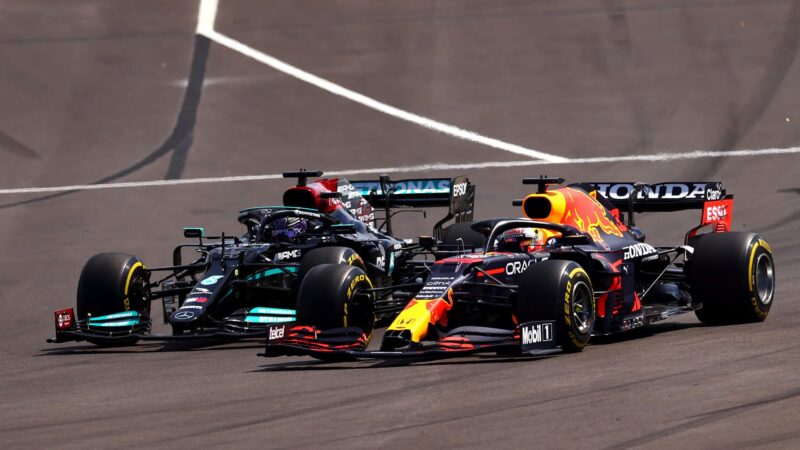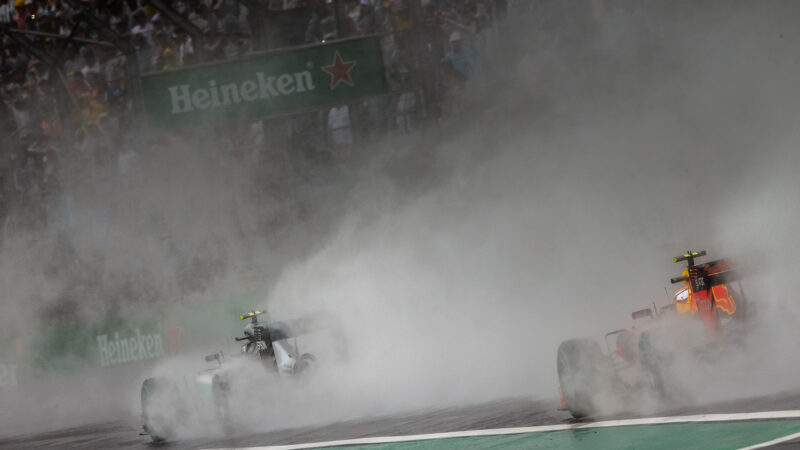Interlagos hills can be level playing field for Hamilton vs Verstappen battle — MPH
Hamilton and Verstappen are so evenly-matched that car performance, not driving ability, has been the biggest factor in the F1 title race. But Interlagos may suit Mercedes and Red Bull equally, writes Mark Hughes

Interlagos's combination of high-speed sections split by the technical infield could mean the Mercedes and Red Bull are evenly matched
Dan Istitene/F1 via Getty Images
Interlagos is perfectly configured to equalise a low-drag-favouring car like the Mercedes with a high-downforce-favouring car like the Red Bull (unless of course it rains heavily, in which case downforce trumps all). But sectors 1 and 3, with their long stretches of flat-out running, naturally favour the low-drag car, with the repeated turns of infield which comprises sector 2 rewarding downforce. Add the time spent in sectors 1 and 3 and it comes out at pretty much the same time spent in sector 2.
It means that the track is unusually insensitive to wing levels – you can get pretty much the same lap time from a variety of different rear wing levels there; they are just delivered in a different way. So in theory both the Red Bull and Mercedes should be able to get into their respective sweet spots. We still have the random variable of the tyres, however.
With two such fundamentally different cars contesting the championship this year, the impact of track layout upon which car is better-suited for aero reasons has been profound. As has the nature of the track surfaces for tyre usage reasons.
Now that we’ve had most of the season to observe the patterns and talk to some of those involved in the concept and running of the two cars, it seems like the Mercedes can generate more front load and in races where protecting the surface of the front tyres is key, that’s a crucial advantage. That’s what won Mercedes the race in Barcelona, allowing them to run the two-stop trap on Verstappen, just like at Hungary in 2019.

Different aero philosophies both work in the dry, but rain would tip the balance Red Bull’s way
Frederic Le Floc'h / DPPI
The Red Bull can generate more rear load, which makes it better on the rear tyres, especially when the challenge is thermal degradation. It can be driven faster before the rears slide and as such when driven to its tyre temperatures, it’s faster.
There are all sorts of complications in the way all this plays out according to the circumstances of the situation. There are complications too from specific track or weather conditions. In cool conditions Mercedes has occasionally been unable to generate the front tyre temperature quickly enough – see Imola, for reasons which may or may not be to do with its long wheelbase. Similarly, the Zandvoort Turn 3 banking prevented the Merc from being able to use the fastest part of the corner. There have been situations where Red Bull has been unable to balance its car around its powerful big rear wing – notably at Budapest and Istanbul.
But it’s played out like this so far:
| Race | Result |
| Bahrain | Red Bull with a small advantage, but Mercedes stole the race with track position. |
| Imola | Red Bull pace advantage reduced, but Merc inability to get front tyre temperature until several laps into a stint lost it any chance of the win even without Hamilton’s error. |
| Portugal | The two cars extremely closely-matched, but the Merc’s ability to control the front tyre temperatures on a much hotter day than Imola allowed Hamilton to make the pass on Verstappen to win. |
| Spain | Merc’s better front tyre temperature control on a day when heat deg was dominant gave it the race-winning advantage. |
| Monaco | On a track which puts so little energy into the tyres, Mercedes again struggled to generate instant front temperatures in qualifying. Red Bull dominant. |
| Baku | Red Bull generally faster but the unique wing dilemma of this track layout means either a small wing for qualifying pace or a big one for race pace. Merc opted for the small one as the only way it could see of getting track position. Red Bull opted for bigger wing – and was, as a result, massively faster around the pit stops, both cars comfortably overcutting Hamilton. |
| France | The cars very close on outright pace, but rear tyre temperatures had to be controlled here and the Red Bull had way more pace around the stops. Got Verstappen ahead and allowed him to control it from there. |
| Styria | Red Bull developments gave it a decisive pace advantage over Mercedes here. |
| Austria | Even more Red Bull developments increased its dominance. |
| Britain | A big Mercedes update brought gains which appeared to put the car back on at least level terms with Red Bull. Cars very evenly matched here. Red Bull in trying to protect front tyre with set up lost a bit of qualifying pace in cooler conditions of Friday qualifying but appeared to have the edge in hot conditions. |
| Hungary | Red Bull simply could not get its car balanced around its big rear wing and actually had to surrender total downforce just to get a balance. Mercedes much quicker. |
| Belgium | Wet qualifying and no race made this inconclusive. |
| Holland | Downforce emphasis of the track, together with Merc’s difficulties on the banking, made this comfortably Red Bull territory. |
| Italy | Low-drag demands of Monza tailor-made for Mercedes and it was, as expected, much the quicker car. |
| Russia | A dominant Mercedes but with the proviso that Verstappen – taking multiple engine penalties – didn’t do a qualifying lap. |
| Turkey | Another venue where the Red Bull could not be balanced. The big grip of the surface induced understeer which couldn’t be tuned out. Mercedes faster as Red Bull sunk back towards the pack. |
| USA | Very closely-matched aero drag/downforce trade-off but the Red Bull could control rear tyre temperatures better – and that allowed it to take and keep track position. |
| Mexico | The Red Bull’s downforce advantage crucial at an altitude where that’s lap time gold dust. |
But all these assessments can only be made in hindsight. A feature of the season has been the sudden inversion of the two cars when one random variable or another has come to acquire more or less significance to the whole.
Many fans would like to believe that the outcome of a race is from Driver A doing a better job than Driver B. Because the two drivers are so evenly matched, that’s rarely been the case this year. The opposing traits of the two quite equally-matched cars has been the dominant mechanism of this season’s thrilling championship.

